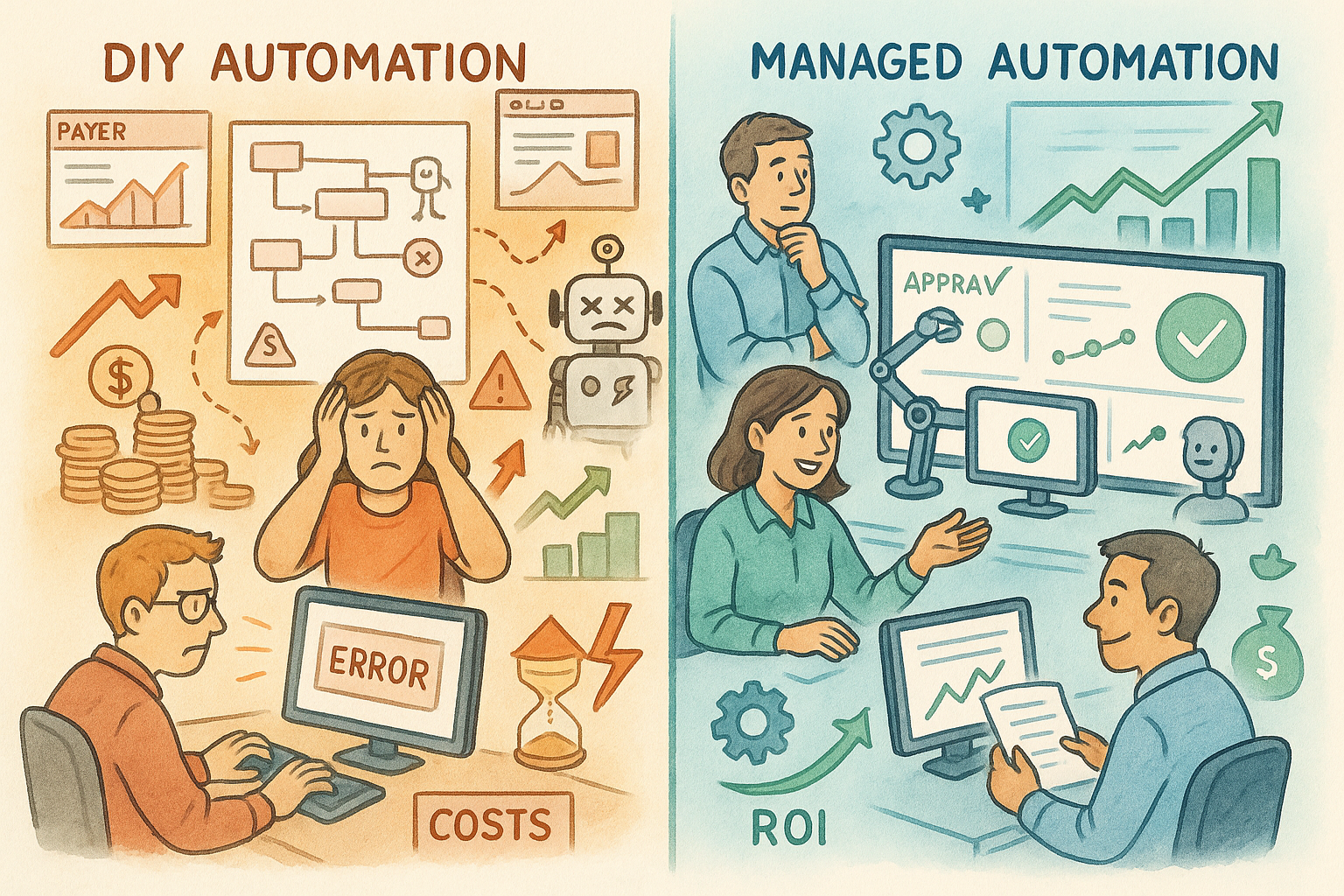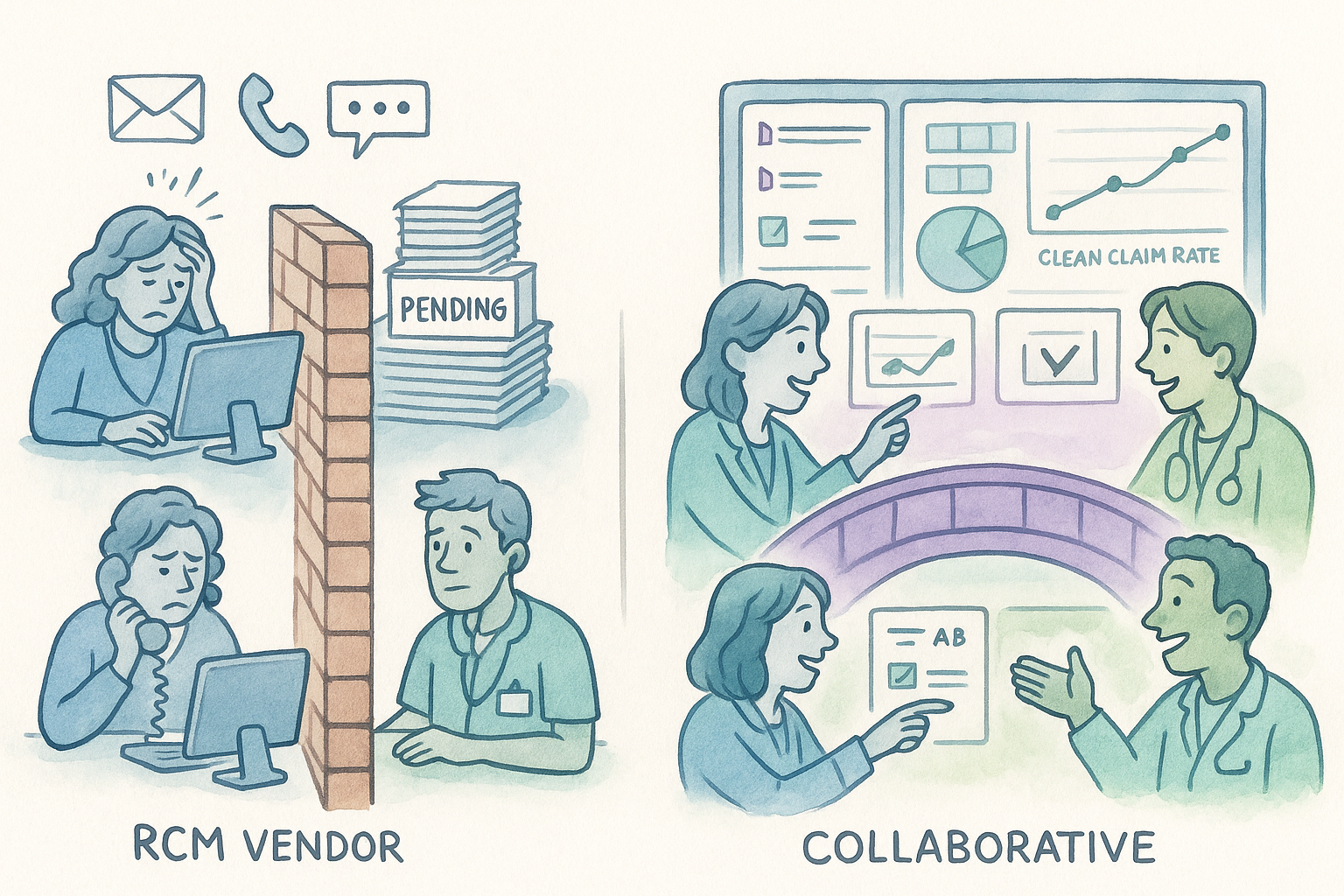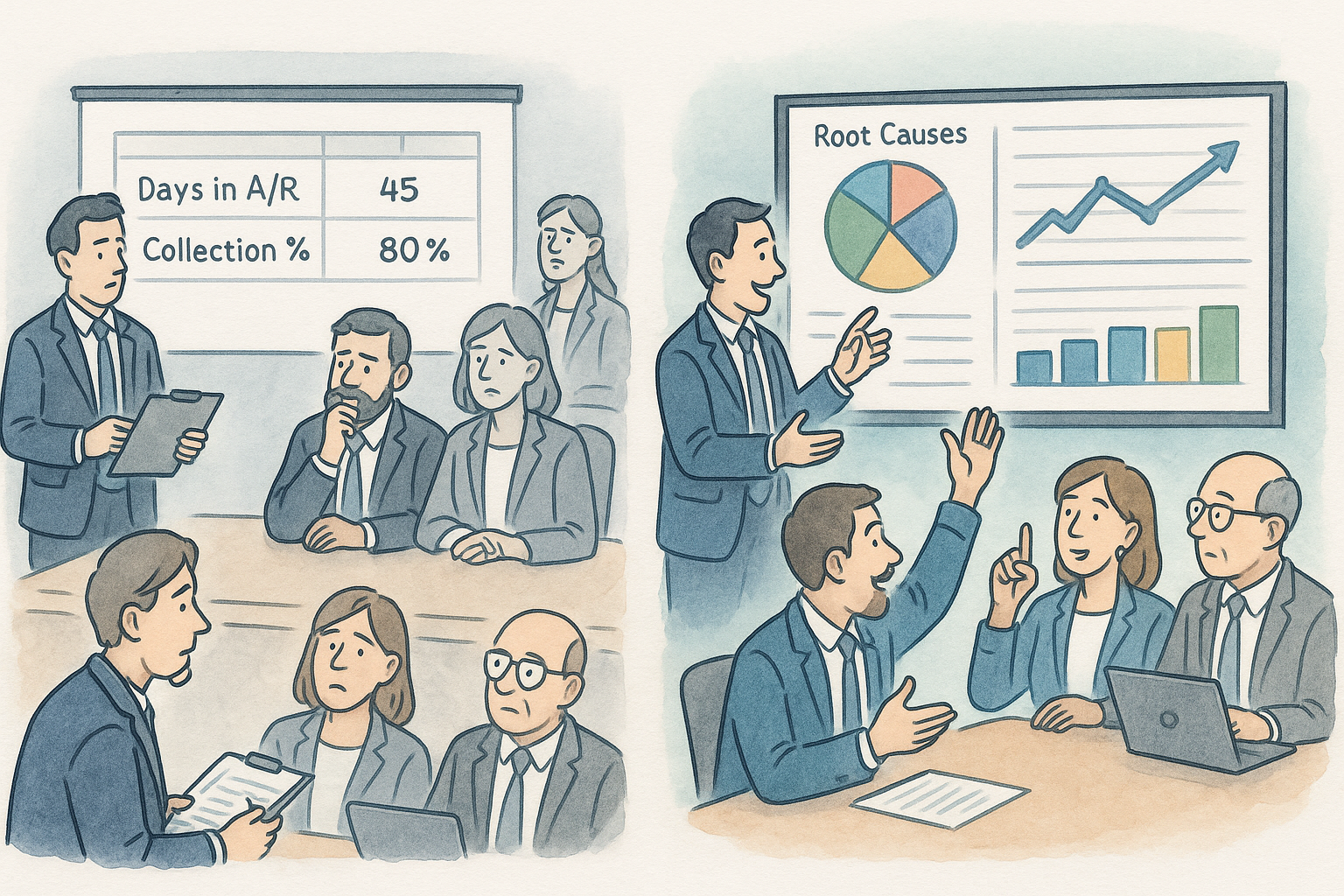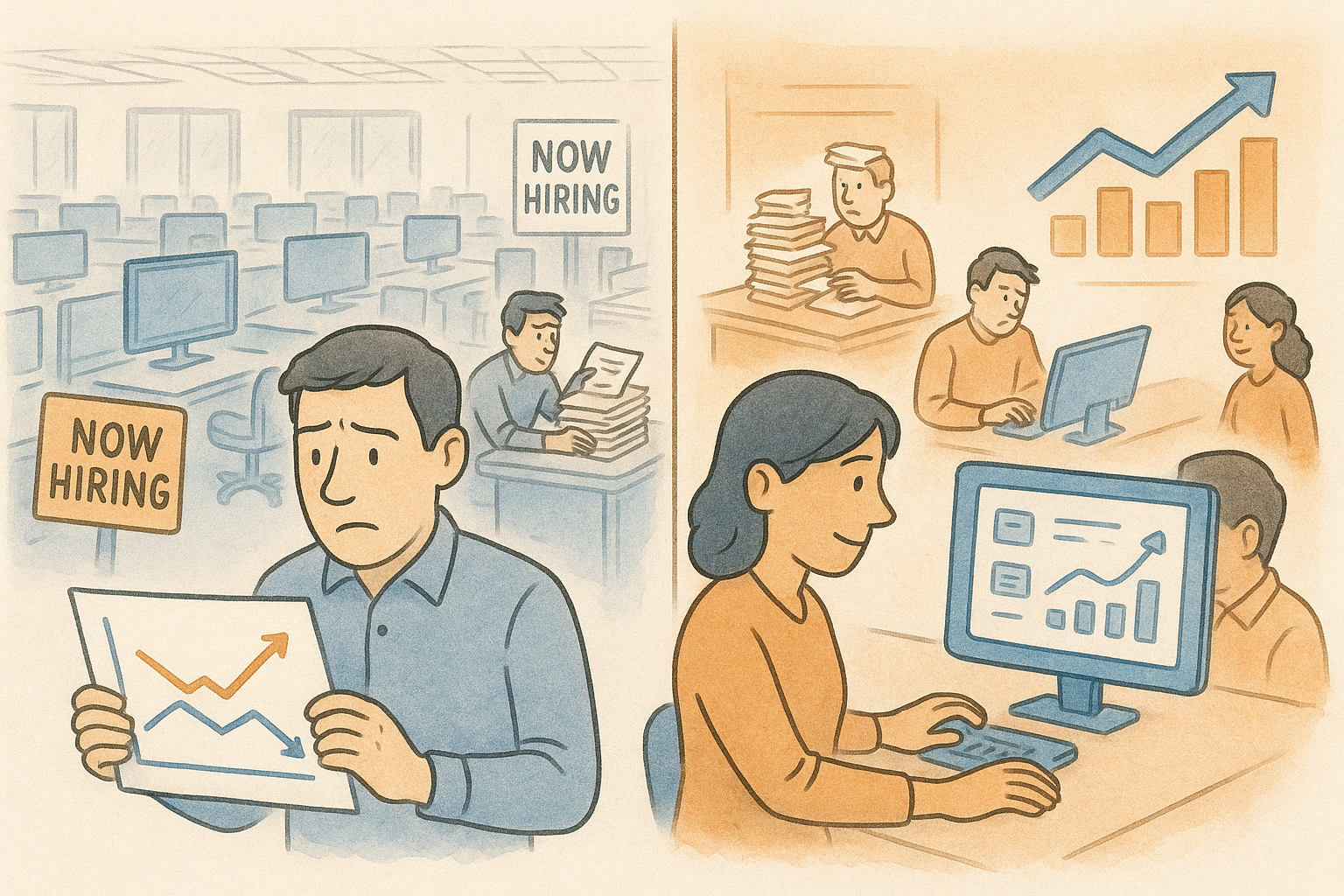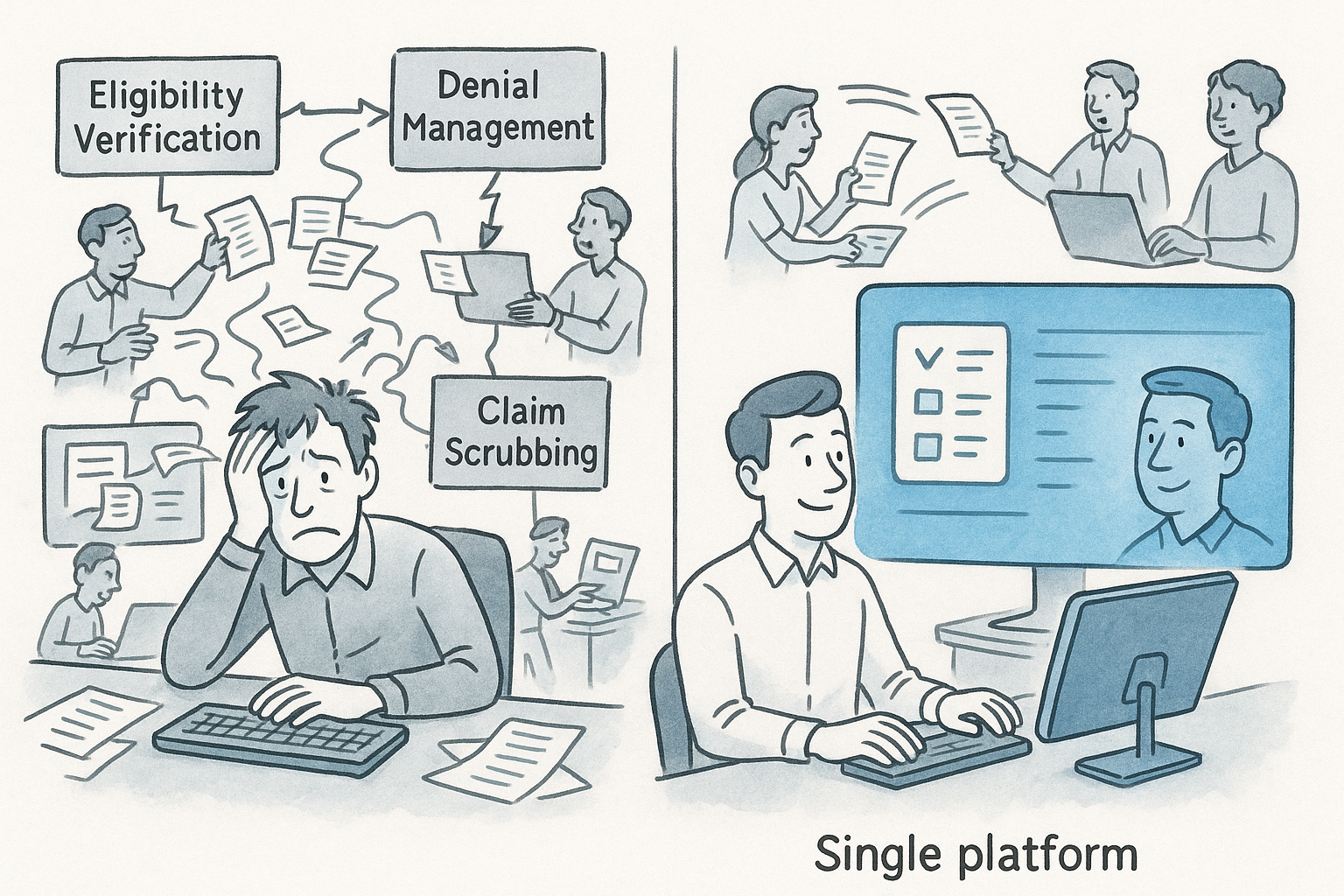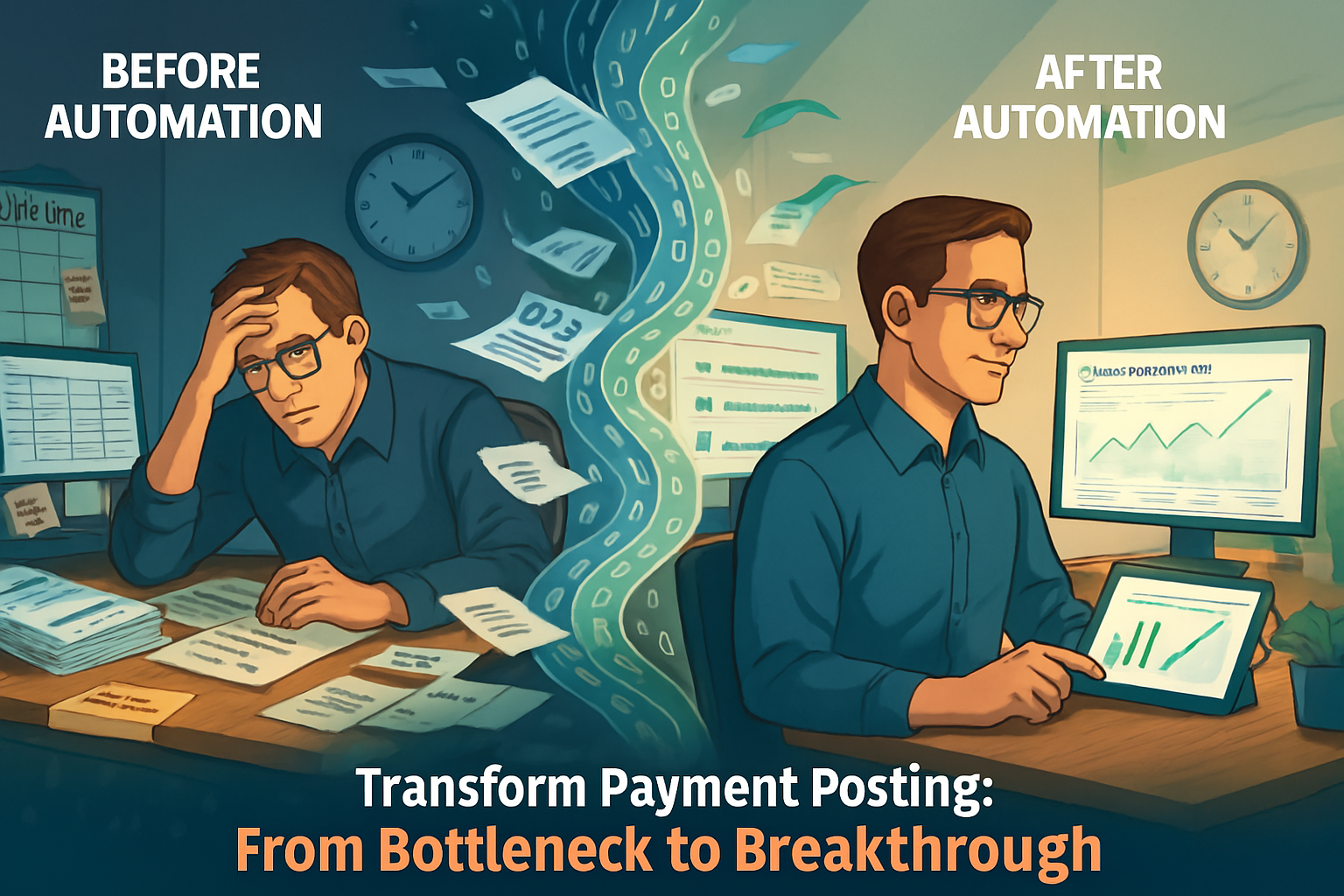Revenue cycle management vendors are under increasing pressure to reduce costs while improving performance. With margins shrinking due to global competition and rising complexity, many have turned to automation—particularly Robotic Process Automation (RPA)—as a solution.
The promise is compelling: deploy software robots to handle repetitive tasks, reduce labor costs, and process claims faster. Yet the reality often falls short of expectations. Industry surveys suggest that between 30-50% of RCM automation initiatives fail to deliver the expected return on investment, with some actually increasing total operating costs.
This disconnect isn’t because automation technology doesn’t work. Rather, it stems from fundamental misconceptions about what it takes to successfully implement and maintain automation in the complex, ever-changing revenue cycle environment.
The Automation Paradox: When Technology Increases Costs
The most puzzling outcome of many automation initiatives is what we call the “automation paradox”—situations where introducing technology designed to reduce costs actually increases them. This typically happens through several mechanisms:
Hidden Infrastructure Costs
Many RCM vendors focus exclusively on the software licensing costs when budgeting for automation, overlooking significant infrastructure requirements:
- Development environments for building and testing automation
- Production environments with sufficient capacity and reliability
- Security and compliance infrastructure to protect PHI
- Backup and recovery systems to prevent data loss
- Monitoring tools to detect automation failures
One mid-sized RCM vendor we worked with discovered that the infrastructure costs for their automation project exceeded the software licensing costs by more than 300%—an expense they hadn’t fully budgeted for.
Underestimated Implementation Effort
Building effective automation requires deep expertise in both the revenue cycle process being automated and the technical implementation:
- Process documentation at a level of detail rarely maintained in most organizations
- Exception handling for dozens or hundreds of potential edge cases
- Integration with multiple systems that may lack proper APIs
- Testing across a wide range of scenarios and data variations
- Change management to ensure staff properly interact with automated processes
A common pattern emerges: what initially appears to be a 3-4 month project extends to 9-12 months, with corresponding cost overruns.
The Maintenance Burden
Perhaps the most significant hidden cost comes after implementation. Revenue cycle automation operates in an environment of constant change:
- Payer policy updates that alter claim requirements
- EHR version upgrades that change screen layouts or data structures
- Regulatory changes that modify documentation or billing requirements
- Client-specific process adjustments that require automation customization
Each change requires reviewing and potentially modifying the automation. As the number of automated processes grows, so does this maintenance burden—often leading to a new full-time position just to maintain existing automation.
Common Pitfalls in RCM Automation Initiatives
Beyond the cost considerations, several common pitfalls undermine the effectiveness of RCM automation projects:
1. Automating Broken Processes
Many organizations rush to automate existing processes without first optimizing them. This approach merely makes inefficient processes run faster, rather than addressing fundamental inefficiencies.
An RCM vendor shared this cautionary tale: “We spent six months automating our denial management workflow, only to realize that 40% of the steps we automated weren’t actually necessary. We should have redesigned the process before automating it.”
2. Underestimating Exception Handling
Revenue cycle processes are notorious for exceptions and edge cases. Automation often works perfectly for the 80% of “normal” scenarios but fails to address the 20% of exceptions—which typically consume 80% of staff time.
Proper exception handling requires:
- Clear identification of possible exceptions
- Decision trees for handling each exception type
- Mechanisms for human intervention when needed
- Ways to “teach” the automation how to handle new exceptions
Without robust exception handling, staff end up spending as much time managing and fixing automation failures as they would have spent processing the work manually.
3. System Change Fragility
Many RPA implementations in revenue cycle rely on screen scraping and UI interaction—approaches that break whenever underlying systems change. This fragility creates significant maintenance overhead:
- EHR updates can change screen layouts, breaking automation overnight
- Payer portal redesigns require complete rebuilding of automation
- Even minor changes like button relocations or field renaming can cause failures
One RCM leader described it this way: “Our automation is like a house of cards. Every time a vendor updates their system, we’re scrambling to fix broken bots before our operation falls behind.”
4. Disconnected Point Solutions
Many organizations implement automation as disconnected point solutions rather than part of an integrated strategy:
- Eligibility verification automation that doesn’t connect to prior authorization processes
- Claim scrubbing automation divorced from denial management
- Payment posting automation separate from reconciliation processes
This fragmentation creates new manual steps to bridge between automated processes, limiting the overall efficiency gain.
5. Insufficient Analytics and Monitoring
Effective automation requires robust monitoring and analytics to:
- Detect failures before they impact operations
- Identify opportunities for optimization
- Measure actual vs. expected performance
- Calculate true ROI over time
Without these capabilities, organizations can’t determine whether their automation is actually delivering value or where adjustments are needed.
Measuring True ROI: Beyond Hours Saved
A fundamental problem in many automation initiatives is the overly simplistic approach to calculating ROI. Most projects focus exclusively on “hours saved” using a formula like:
ROI = (Hours saved × Labor cost per hour) ÷ (Implementation cost + Ongoing costs)
This approach fails to capture the full financial impact in several ways:
Incorporating All Costs
A comprehensive ROI calculation must include:
- Software licensing for all tools involved
- Infrastructure costs (servers, security, monitoring)
- Implementation services (internal and external)
- Ongoing maintenance and adjustment labor
- Training costs for staff interacting with automation
- Opportunity cost of resources diverted to automation
Recognizing Diminishing Returns
Early automation typically targets “low-hanging fruit”—high-volume, standardized processes with significant labor requirements. As these opportunities are exhausted, each new automation project typically yields less benefit while potentially adding the same infrastructure and maintenance costs.
Accounting for Process Interdependencies
Automating one part of the revenue cycle often affects other areas in ways not reflected in simple hour-reduction calculations:
- Faster claim submission may increase rejection rates if quality checks are bypassed
- Automated eligibility verification may create more work in denial management if not implemented correctly
- Streamlined payment posting might create reconciliation challenges downstream
Quality and Accuracy Impacts
Automation can either improve or reduce work quality, with corresponding financial impacts:
- Reduced denial rates through consistent processing
- Improved patient experience through faster responses
- Potentially increased compliance risks if automation lacks proper controls
One RCM vendor developed a more sophisticated ROI formula that incorporated these factors and discovered that only 40% of their planned automation projects actually delivered positive financial returns—a realization that allowed them to prioritize more effectively.
The Managed Automation Alternative
Given these challenges, forward-thinking RCM vendors are shifting from a do-it-yourself approach to managed automation solutions. This approach addresses many of the pitfalls described above:
Purpose-Built vs. General-Purpose
Rather than using general-purpose RPA tools that require extensive customization, managed automation solutions are specifically designed for revenue cycle workflows:
- Pre-built integration with major EHRs and practice management systems
- Workflow templates optimized for revenue cycle processes
- Industry-specific compliance and security features
- Analytics designed around RCM key performance indicators
Externalized Maintenance Burden
Perhaps the biggest advantage of managed solutions is shifting the maintenance burden to the vendor:
- The solution provider handles updates when payer requirements change
- System integration is maintained as EHRs and other platforms evolve
- Technical infrastructure is provided and maintained by the vendor
- Compliance with healthcare regulations is built-in and updated automatically
Balanced Human-Machine Collaboration
The most effective approaches focus on augmenting rather than replacing human staff:
- Automation handles data gathering and routine processing
- Staff focus on exception handling and judgment-based decisions
- Analytics identify where human intervention is most valuable
- The division of labor evolves as automation capabilities advance
Shared Risk Model
Unlike traditional automation where the RCM vendor bears all the risk of implementation failure, managed solutions typically offer:
- Usage-based pricing aligned with actual value delivered
- Shared success metrics tied to performance improvement
- Incremental implementation that limits initial investment
- Ongoing optimization as part of the service
Strategic vs. Tactical Automation: A Framework for Success
Whether pursuing in-house automation or adopting managed solutions, RCM vendors benefit from distinguishing between strategic and tactical automation opportunities:
Characteristics of Strategic Automation
- Addresses critical bottlenecks affecting multiple processes
- Provides competitive differentiation in client-facing activities
- Creates scalability for core business operations
- Delivers clear, measurable improvements in key performance indicators
Characteristics of Tactical Automation
- Addresses isolated process steps with clear boundaries
- Focuses on internal efficiency rather than client experience
- Targets stable processes unlikely to change frequently
- Offers quick implementation with minimal process redesign
Prioritizing strategic opportunities while carefully selecting tactical projects based on stability and impact helps organizations maximize automation ROI.
Case Study: Comparing In-House and Managed Automation Approaches
A revealing case study comes from an RCM vendor that simultaneously pursued in-house automation for some processes and adopted managed automation for others. This side-by-side comparison revealed significant differences in outcomes:
In-House Automation Project: Eligibility Verification
- Initial Implementation Cost: $175,000
- Timeline: 7 months (vs. 4 months planned)
- Annual Maintenance: $120,000 (1.5 FTEs)
- Process Improvement: 65% reduction in manual work
- ROI Achievement: 22 months (vs. 12 months projected)
Managed Automation Approach: Denial Management
- Initial Implementation Cost: $90,000
- Timeline: 3 months
- Annual Subscription: $144,000 (includes all maintenance)
- Process Improvement: 73% reduction in manual work
- ROI Achievement: 9 months
The vendor’s CIO observed: “What we didn’t account for with our in-house approach was how much ongoing effort would be required just to maintain the automation. Every payer website change, every EHR update became our problem to fix. With the managed solution, that was all handled for us.”
Implementation Framework: Evaluating Automation Readiness
Not all revenue cycle processes are equally suitable for automation. This evaluation framework helps identify processes most likely to deliver positive ROI:
Process Stability
- How frequently does the process change?
- Is it subject to regular payer policy updates?
- Does it rely on systems that undergo frequent updates?
Exception Frequency
- What percentage of instances follow the standard path?
- How complex are the exceptions?
- Can exceptions be clearly categorized and handled algorithmically?
Integration Requirements
- How many different systems are involved?
- Do these systems have robust APIs or require screen scraping?
- Is data consistently formatted across systems?
Value Potential
- How many labor hours does the process currently consume?
- What is the strategic importance of the process?
- Would automation improve quality and accuracy?
Processes scoring high on stability and value while scoring low on exception frequency and integration complexity typically offer the best automation candidates.
Conclusion: A More Sustainable Approach to RCM Automation
Automation will undoubtedly play an important role in the future of revenue cycle management. However, successful implementation requires moving beyond the simplistic view of automation as a quick fix for margin pressure.
The most successful RCM vendors are taking a more nuanced approach:
- Carefully evaluating processes for automation suitability rather than pursuing technology for its own sake
- Considering managed automation options that externalize maintenance and technical complexity
- Implementing robust analytics to accurately measure results and ROI
- Focusing on human-machine collaboration rather than staff replacement
- Building automation into an overall operational strategy rather than pursuing disconnected point solutions
In the words of one RCM operations leader: “We no longer think of automation as a project with a beginning and end. It’s an ongoing capability that requires continuous management, measurement, and refinement.”
By adopting this more sophisticated view of automation’s role in revenue cycle, vendors can avoid the pitfalls that have led to disappointing results for many early adopters while still capturing the very real benefits that effective automation can deliver.
Lockbox provides RCM vendors with managed automation that reduces costs without the maintenance burden of DIY approaches. Learn how our integrated platform can transform your revenue cycle operations at www.lockboxai.com.
